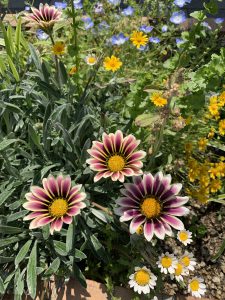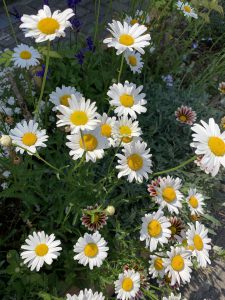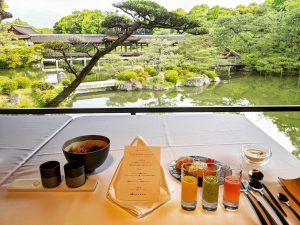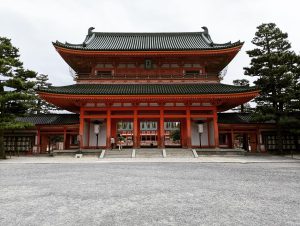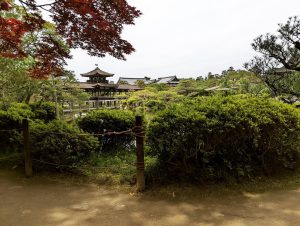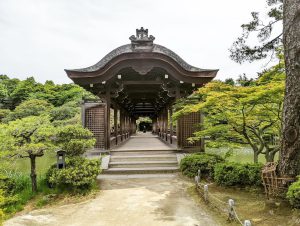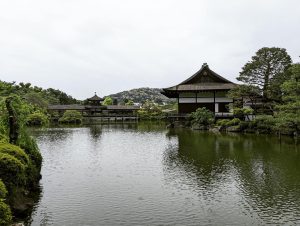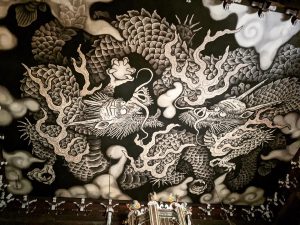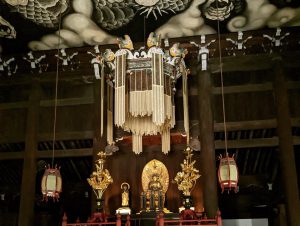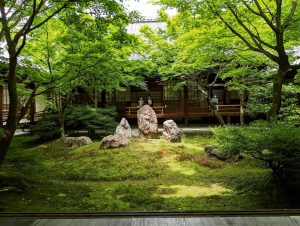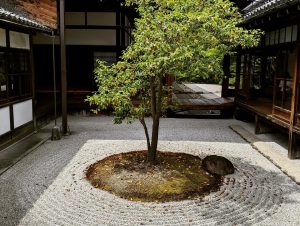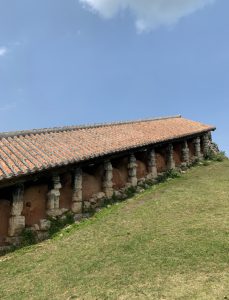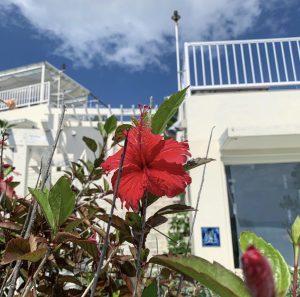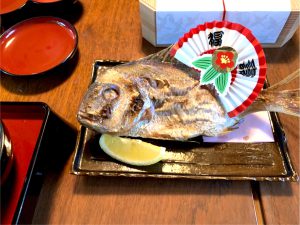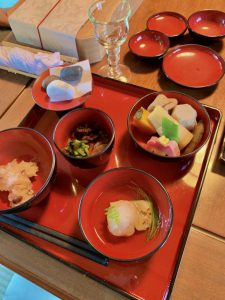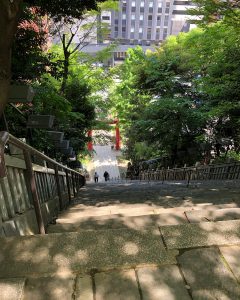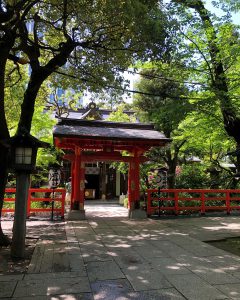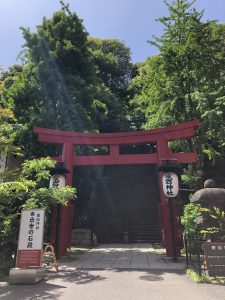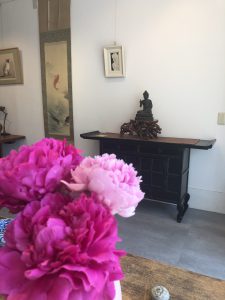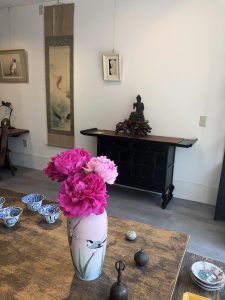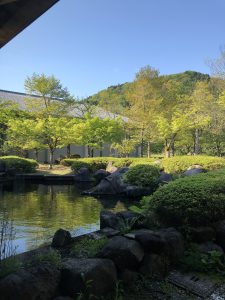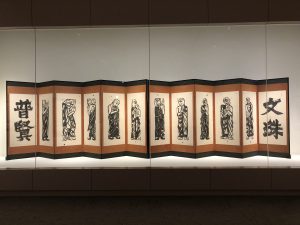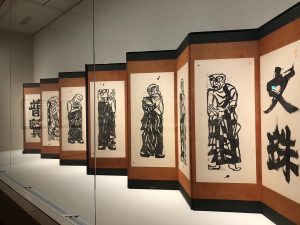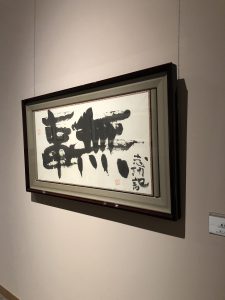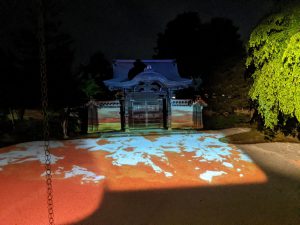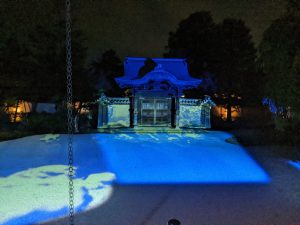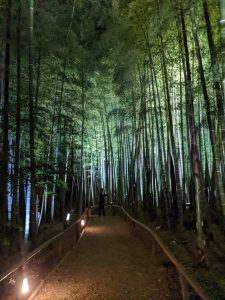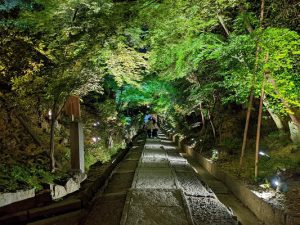みなさまこんにちは、スタッフNでございます。
GWが終わり京都から帰ってきて、街中に神社やお寺が見えないのが少し寂しく感じます。
今回は、あの有名な伏見稲荷大社について調べていきたいと思います。
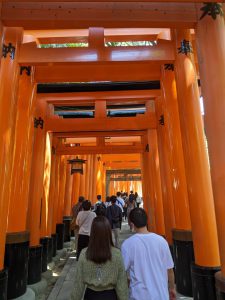
伏見稲荷大社(ふしみいなりたいしゃ)は、京都市伏見区深草にある神社で、全国に約3万社あるといわれる稲荷神社の総本社でございます。初詣では近畿地方の社寺で最多の参拝者を集めます。
清少納言が自らの稲荷詣を『枕草子』に記すほか、『蜻蛉日記』『今昔物語集』など古典にもしばしば登場致します。延喜8年(908年)に左大臣藤原時平が三箇社を修営(『年中行事秘抄』)、その後源頼朝や足利義教らが社殿の造営、修造に関わったが、応仁の乱にてすべて焼亡致します。
明治政府の神仏分離令によって、本願所のほか境内の仏堂がすべて廃寺となる一方、崇敬者による鳥居の奉納や私的な「お塚」の建立が稲荷山中で顕著化し、現在の伏見稲荷大社を特徴づけるものとなりました。
しかし、皆さまご存知の通り、伏見稲荷大社は往復2時間以上かかる過酷な場所でございます。
昔のきつかった思い出を思い出して登りましたが、やはりきつかったです。
途中、浴衣の女の子とすれ違い、悪いことは言わないからやめた方がいいというのを我慢して下っておりました。
鳥居で日陰になるのと、山の中なので暑さは和らぐのですが、日陰のない頂上は暑かったです。
しかも、月に1回のお稲荷さんの参拝の時間にあたってしまい、炎天下の中並ぶことになりました。
宮司さんが唱えていて、よくわからずにその場にいたのですが、こちらにもお祓いをしてくださりました。
一瞬何かの行事に時間が当たってしまったのかと思ったのですが、珍しい儀式に立ち会えて運が良かったです。
売店がある度につれに「何か食べない?」と聞いて断られ、8か所目でやっとお抹茶アイスを食べることができました。
途中滝の道に入り込んでしまい、Uターンしたりしましたが、何とか帰ってくることができました。
今流行りの漫画、呪術廻戦の聖地巡礼などもできるようです。
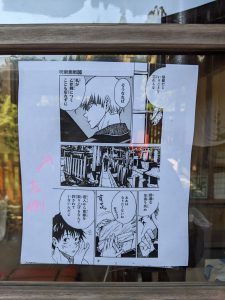
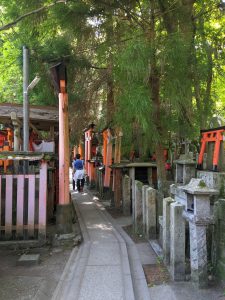
私が伏見稲荷大社で楽しみなのが、保護猫に会えることでございます。
途中の売店や山頂などところどころに猫がおります。
お腹を見せてゴロゴロする、人懐こい子もおりました。
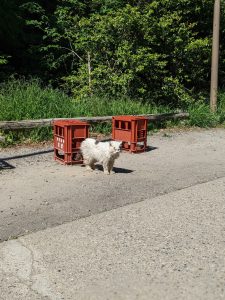
都会でありながら、大自然で、神様も近くにいる遊び場は楽しそうですね。
伏見稲荷大社と言えば千本鳥居ですが、現在は1万本以上あり、いまだに増え続けているそうです。
近年は外国人観光客からも観光地として人気があり、トリップアドバイザーによる「外国人に人気の日本の観光スポット」調査では2019年まで6年連続で1位となっているそうでうす。駅のごく近くに赤い鳥居が続く非常に日本的な風景が広がり、拝観料不要で閉門時間が無く、稲荷山のお山巡りで欧米人が好むウォーキングができることなどから高評価を得ている。平日のほとんどの日そうです。外国人観光客の方が日本人よりも多くなっており、日没後も稲荷山に登る外国人が多くなっています。本殿付近はライトアップされており、稲荷山への参道も脇道以外は全区間で街灯が1晩中点灯されており夜間の参拝もできるみたいです。ただし、イノシシが出没するとか。

平安時代後期に熊野詣が盛んになると、京の公家や民衆は参詣の途中で伏見稲荷に立ち寄り、縁起に因む杉木の枝を頂いて身体につけることが流行したそうです。(『為房卿記』など)。『平治物語』でも平清盛が急な六波羅への警備にも「先ず稲荷の杜にまいり、各々杉の枝を折って、鎧の袖にさして(略)」とある。初午参詣で皆が杉木の枝をとっていくので稲荷山の杉はすっかり葉がなくなった」と詠んだ藤原光俊の歌が残っております。
神体山である稲荷山は、東山三十六峰の最南端に位置し、標高233m。3つの峰(一ノ峰、二ノ峰、三ノ峰)が連なっていますが、かつては古墳で、それぞれに円墳が確認されています。三ノ峰からは二神二獣鏡が出土しています。この山々「お山」を中世には「下ノ塚」「中ノ塚」「上ノ塚」と呼び、奥社奉拝所の先にある山々を巡拝できる参道には、そこかしこに人々が石碑に「白狐大神」や「白龍大神」などの神名を刻んで祀られた無数の小さな祠(その数、1万基、あるいはそれ以上とも言われる)の「お塚」が奉納されており、「お塚信仰」と呼ばれております。
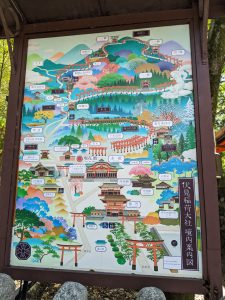
参拝者の中には、「お塚」の前にひざまづいて「般若心経」や「稲荷心経」などを唱えている人もおり、日本で神仏分離が行われる前の信仰(神仏習合を参照)が今でも保たれているのを見ることができます。奥社奉拝所の奥に「おもかる石」という石があり、願いを念じて持ち上げた時、重さが予想していたより軽ければ願いが叶い、重ければその願いは叶わないといわれています。
学生時代におもかるいしがあがらず無理やりあげようとして落としそうになったことがあるので、それ以来Nはやっていません。願いが大きすぎたのだと思うことに致します。
鳥居を奉納する習わしは江戸時代に始まったそうです。
応仁の乱で焼失する前は稲荷山の山中にお社がありましたが、再建はされず現在は神蹟地として残っています。
「稲荷大神様」のお使い(眷族)はきつねとされていますが、野山に居る狐ではなく、眷属様も大神様同様に我々の目には見えません。そのため白(透明)狐=“びゃっこさん”といってあがめます。
「稲荷大神様」はきつねではないそうです。
お稲荷さんの境内は、京都のいわゆる「東山36峯」の一番南に位置する稲荷山が大部分を占めています。その西麓一帯を含め約26万坪(約87万平方メートル)が境内です。因みに甲子園球場は39,600平方メートルと言われており、約22倍の面積です。それは2時間もかかるわけでございますね。
ちなみに古美術風光舎名古屋店の近くにも豊玉稲荷社がございます。
お近くにお立ち寄りの際にはぜひお越しくださいませ。
ではでは
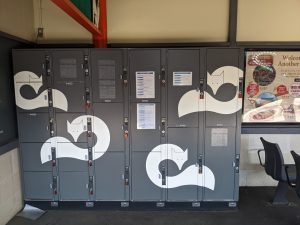
Hello everyone, this is Staff N.
When the Golden Week holidays are over and I come back from Kyoto, I feel a little lonely that I can’t see the shrines and temples in the city.
This time, I would like to investigate the famous Fushimi Inari Taisha Shrine.
Fushimi Inari Taisha is a shrine located in Fukakusa, Fushimi-ku, Kyoto, and is the head office of Inari Shrine, which is said to have about 30,000 companies nationwide. At the first visit, we gather the largest number of worshipers at shrines and temples in the Kinki region.
In addition to writing his own Inari pilgrimage in “The Pillow Book,” Sei Shonagon often appears in classics such as “The Pillow Book” and “The Storybook of the Past and Present.” In the 8th year of Engi (908), the Minister of the Left, Fujiwara no Tokihira, trained three shrines (“Annual Event Secret Extract”), after which Minamoto no Yoritomo and Yoshinori Ashikaga were involved in the construction and repair of the shrine, but due to the Onin War. All will be burnt down.
Due to the Meiji government’s decree to separate Shinto and Buddhism, all the Buddhist temples in the precincts of the temple were abandoned. It became what characterizes.
However, as you all know, Fushimi Inari Taisha is a harsh place that takes more than 2 hours for a round trip.
I remembered the hard memories of the old days and climbed, but it was still hard.
On the way, I passed by a girl in a yukata and put up with the idea that I should stop because I wouldn’t say anything bad.
It was shaded by the torii gate and the heat was softened because it was in the mountains, but the summit without shade was hot.
Moreover, it was time for Inari to worship once a month, and we were lined up in the scorching sun.
Mr. Miyaji was chanting, and I was there without knowing it well, but he also prayed for me.
I wondered if some event had been hit for a moment, but I was lucky to be able to witness a rare ritual.
Every time there was a shop, I was asked “Would you like to eat something?” And refused, and I was finally able to eat green tea ice cream at the 8th place.
I got into the waterfall road on the way and made a U-turn, but I managed to come back.
It seems that you can also do popular manga and pilgrimage to the sacred place of the magical war.
What I am looking forward to at Fushimi Inari Taisha is meeting protected cats.
There are cats in places such as shops and mountain peaks on the way.
There was also a friendly child who showed his stomach and was rumbling.
Even though it’s an urban area, it’s a wilderness, and the playground near God seems to be fun.
Speaking of Fushimi Inari Taisha, there are 1,000 torii gates, but now there are more than 10,000, and it seems that the number is still increasing.
In recent years, it has become popular as a tourist destination among foreign tourists, and according to the “Japanese tourist spots popular with foreigners” survey by TripAdvisor, it is said that it has been ranked first for six consecutive years until 2019. A very Japanese landscape with red torii gates spreads very close to the station, there is no admission fee and there is no closing time, and it is highly evaluated because it is possible for Westerners to walk around Mt. Inari. Most days on weekdays. There are more foreign tourists than Japanese, and more foreigners climb Mt. Inari even after sunset. The area around the main shrine is lit up, and the streetlights are lit all night except for the side roads on the approach to Mt. Inari, so it seems that you can worship at night. However, wild boars appear.
When the Kumano pilgrimage became popular in the latter half of the Heian period, it was popular for Kyoto officials and people to stop by Fushimi Inari during the pilgrimage and get a branch of a cedar tree associated with auspiciousness and attach it to their body. (“Sir Tamafusa” etc.). In “Heiji Monogatari”, Taira no Kiyomori also says “First come to Inari no Mori, fold the branches of each cedar, and put them on the sleeves of the armor (omitted)” to guard Rokuhara. Mitsutoshi Fujiwara’s song remains, saying, “Since everyone picks up the branches of the cedar tree at the beginning of the day, the cedars of Mt. Inari have completely lost their leaves.”
Mt. Inari, which is a sacred mountain, is located at the southernmost tip of the 36 peaks of Higashiyama and has an altitude of 233m. There are three peaks (Ichinomine, Ninomine, Sannomine) in a row, but once it was an old burial mound, a circular burial mound was confirmed in each. Two gods and two beast mirrors have been excavated from Mt. Sannomine. These mountains “Oyama” are called “Shimonozuka”, “Nakanozuka”, and “Uenozuka” in the Middle Ages, and people are everywhere on the approach to the mountains beyond the Okusha Hohaisho. A myriad of small shrines (the number of which is said to be 10,000 or more) enshrined with god names such as “White Fox Omikami” and “White Dragon Omikami” on the stone monument are dedicated. It is called “Otsuka faith”.
Some worshipers kneel in front of “Otsuka” and chanting “Heart Sutra” and “Inari Shingyō”, and the belief before the separation of Shinto and Buddhism in Japan (Shinbutsu). You can see that (see Practice) is still maintained. There is a stone called “Omokaru Stone” in the back of the Okusha Hohaisho, and it is said that if the weight is lighter than expected, the wish will come true, and if it is heavy, the wish will not come true. increase.
When I was a student, I wasn’t happy with it and tried to force it down, so I haven’t done N since then. I think my wish was too big.
The practice of dedicating a torii is said to have started in the Edo period.
Before it was burned down by the Onin War, there was a shrine in the mountains of Mt. Inari, but it was not rebuilt and now remains as a sacred place.
The messenger of “Inari Okami” is said to be a fox, but not the fox in Noyama, but the genus is invisible to us as well as Okami. Therefore, I admire the white (transparent) fox = “Byakko-san”.
“Inari Okami” is not a fox.
Inari’s precincts are dominated by Mt. Inari, which is located in the southernmost part of the so-called “Higashiyama 36 Mine” in Kyoto. The precincts are about 260,000 tsubo (about 870,000 square meters) including the western foot of the area. By the way, Koshien Stadium is said to be 39,600 square meters, which is about 22 times the area. It takes two hours, doesn’t it?
By the way, there is Toyotama Inari Shrine near the antique art Fukosha Nagoya store.
Please come and visit us when you are near us.
See you soon
*********************
爽やかなお天気が続いておりますね。お片付けなどされてる方もおおいのではないでしょうか。
風光舎では、古美術品や骨董品の他にも絵画や宝石、趣味のお品など様々なジャンルのものを買受しております。
お片付けをされていて、こういうものでもいいのかしらと迷われているものでも、どうぞお気軽にご相談下さいませ。
また風光舎は、出張買取も強化しております。
ご近所はもちろん、愛知県内、岐阜県、三重県その他の県へも出張いたします。
まずは、お電話お待ちしております。
愛知県名古屋市千種区・骨董 買取
『古美術 風光舎 名古屋店』
